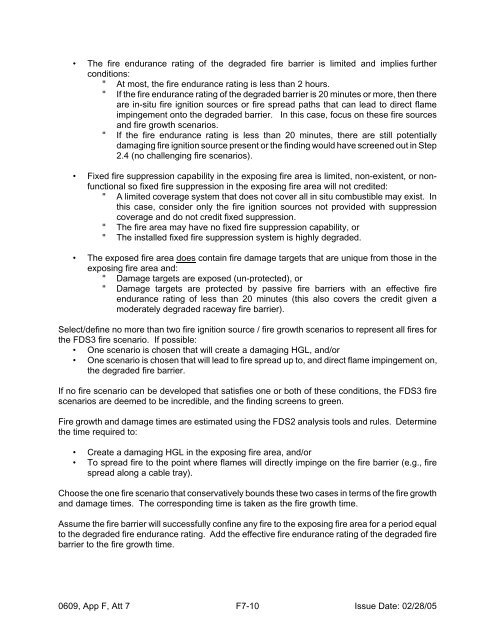IMC 0609, App F, Att 7 - NRC
IMC 0609, App F, Att 7 - NRC
IMC 0609, App F, Att 7 - NRC
You also want an ePaper? Increase the reach of your titles
YUMPU automatically turns print PDFs into web optimized ePapers that Google loves.
• The fire endurance rating of the degraded fire barrier is limited and implies further<br />
conditions:<br />
" At most, the fire endurance rating is less than 2 hours.<br />
" If the fire endurance rating of the degraded barrier is 20 minutes or more, then there<br />
are in-situ fire ignition sources or fire spread paths that can lead to direct flame<br />
impingement onto the degraded barrier. In this case, focus on these fire sources<br />
and fire growth scenarios.<br />
" If the fire endurance rating is less than 20 minutes, there are still potentially<br />
damaging fire ignition source present or the finding would have screened out in Step<br />
2.4 (no challenging fire scenarios).<br />
• Fixed fire suppression capability in the exposing fire area is limited, non-existent, or nonfunctional<br />
so fixed fire suppression in the exposing fire area will not credited:<br />
" A limited coverage system that does not cover all in situ combustible may exist. In<br />
this case, consider only the fire ignition sources not provided with suppression<br />
coverage and do not credit fixed suppression.<br />
" The fire area may have no fixed fire suppression capability, or<br />
" The installed fixed fire suppression system is highly degraded.<br />
• The exposed fire area does contain fire damage targets that are unique from those in the<br />
exposing fire area and:<br />
" Damage targets are exposed (un-protected), or<br />
" Damage targets are protected by passive fire barriers with an effective fire<br />
endurance rating of less than 20 minutes (this also covers the credit given a<br />
moderately degraded raceway fire barrier).<br />
Select/define no more than two fire ignition source / fire growth scenarios to represent all fires for<br />
the FDS3 fire scenario. If possible:<br />
• One scenario is chosen that will create a damaging HGL, and/or<br />
• One scenario is chosen that will lead to fire spread up to, and direct flame impingement on,<br />
the degraded fire barrier.<br />
If no fire scenario can be developed that satisfies one or both of these conditions, the FDS3 fire<br />
scenarios are deemed to be incredible, and the finding screens to green.<br />
Fire growth and damage times are estimated using the FDS2 analysis tools and rules. Determine<br />
the time required to:<br />
• Create a damaging HGL in the exposing fire area, and/or<br />
• To spread fire to the point where flames will directly impinge on the fire barrier (e.g., fire<br />
spread along a cable tray).<br />
Choose the one fire scenario that conservatively bounds these two cases in terms of the fire growth<br />
and damage times. The corresponding time is taken as the fire growth time.<br />
Assume the fire barrier will successfully confine any fire to the exposing fire area for a period equal<br />
to the degraded fire endurance rating. Add the effective fire endurance rating of the degraded fire<br />
barrier to the fire growth time.<br />
<strong>0609</strong>, <strong>App</strong> F, <strong>Att</strong> 7 F7-10<br />
Issue Date: 02/28/05
















